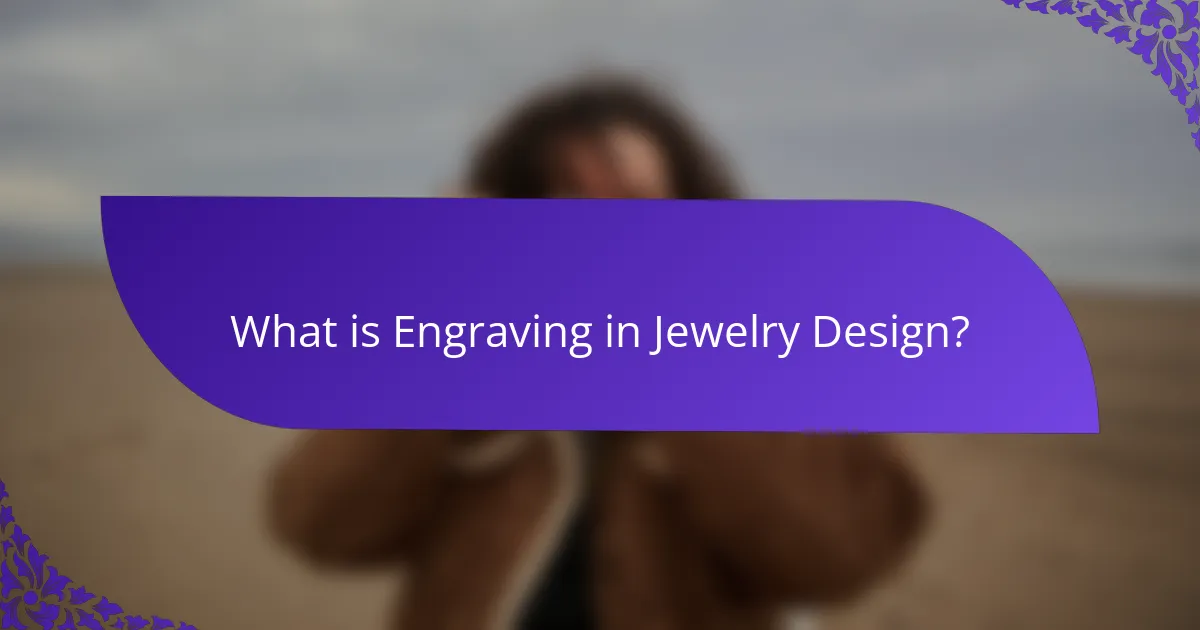Engraving in jewelry design is the technique of carving or etching designs onto jewelry pieces, enhancing their aesthetic appeal. This process can be executed manually with specialized tools or through laser technology, allowing for intricate patterns and personalization, such as names or dates. Essential tools for engraving include gravers, burins, and microscopes, which aid in achieving precision and detail. Engraving serves various purposes, including personalization, decorative enhancement, and commemoration, and has historical significance dating back to ancient civilizations. The versatility of engraving makes it a fundamental aspect of modern jewelry design.

What is Engraving in Jewelry Design?
Engraving in jewelry design is the process of carving or etching designs onto the surface of jewelry pieces. This technique enhances the aesthetic appeal of items such as rings, bracelets, and pendants. Engraving can be done manually or with the help of machines. Common methods include hand engraving and laser engraving. Hand engraving uses specialized tools to create intricate designs. Laser engraving employs high-powered lasers for precision and detail. Engraving allows for personalization, such as adding names or dates. This practice has been used for centuries, dating back to ancient civilizations. The versatility of engraving makes it a popular choice in modern jewelry design.
How is engraving defined in the context of jewelry?
Engraving in the context of jewelry is the process of incising a design onto a hard surface. This technique allows artisans to add intricate details or personalized messages to various jewelry pieces. Engraving can be done using hand tools or machines, depending on the desired precision and complexity. Common materials for engraving include metals like gold, silver, and platinum. The practice dates back to ancient civilizations, where it was used for both decorative and functional purposes. Today, engraving is widely used for personalization, such as adding names, dates, or symbols to rings and pendants. This enhances the sentimental value of the jewelry, making it unique to the wearer.
What are the historical origins of engraving in jewelry?
Engraving in jewelry dates back to ancient civilizations. The earliest evidence of engraving appears in Mesopotamia around 3000 BCE. Artisans used simple tools to carve designs into metal and gemstones. This technique was employed for both decorative and functional purposes. Ancient Egyptians also practiced engraving, often inscribing hieroglyphs on jewelry. The Greeks further developed engraving techniques, creating intricate designs on gold and silver. By the Middle Ages, engraving became a respected art form in Europe. It was used to personalize items and create detailed imagery. Today, engraving remains a vital aspect of jewelry design.
What distinguishes engraving from other jewelry design techniques?
Engraving is distinguished from other jewelry design techniques by its method of creating designs through incising or carving into the surface of the metal. This technique allows for intricate detail and personalization that other methods, like casting or soldering, cannot achieve. Engraving can produce fine lines, textures, and patterns that enhance the visual appeal of the piece. Unlike enameling, which involves adding color to the surface, engraving modifies the metal itself. Historical records indicate that engraving has been used since ancient times for decorative and functional purposes. This long-standing tradition underscores its significance in jewelry design.
What are the different types of engraving techniques?
The different types of engraving techniques include hand engraving, machine engraving, and laser engraving. Hand engraving involves manually carving designs into the surface of the material using specialized tools. This technique allows for intricate and personalized designs. Machine engraving utilizes a computer-controlled machine to create precise engravings. It is often faster and can produce consistent results across multiple pieces. Laser engraving uses a focused laser beam to etch designs into materials. This method is known for its speed and ability to create detailed images. Each technique has its own advantages and is chosen based on the desired outcome and material.
What is hand engraving, and how is it performed?
Hand engraving is a technique where designs are carved into a hard surface using specialized tools. It is commonly used in jewelry design to create intricate patterns and personalized inscriptions. The process involves holding a graver, which is a small, sharp tool, at a precise angle against the material. The engraver moves the tool along the surface, removing small amounts of material to form the desired design.
Various techniques can be employed during hand engraving, including line engraving and stippling. Line engraving creates detailed lines, while stippling produces textured effects through small dots. The engraver requires skill and precision to control the depth and angle of each cut.
Historically, hand engraving has been used for centuries in various cultures. It remains a valued art form in jewelry making, allowing for customization and artistic expression.
What are machine engraving methods, and how do they differ from hand engraving?
Machine engraving methods utilize automated tools to carve designs into materials. These methods include laser engraving, rotary engraving, and CNC engraving. Machine engraving offers precision and consistency. It can produce intricate details quickly and efficiently. In contrast, hand engraving relies on manual tools and skilled artisans. Hand engraving allows for unique artistry and personal touch. However, it is typically more time-consuming and less uniform than machine engraving. Machine engraving can handle larger production volumes. Hand engraving often results in one-of-a-kind pieces. Each method has its own advantages and applications in jewelry design.
What is laser engraving, and what advantages does it offer?
Laser engraving is a precise method of marking or cutting materials using a focused laser beam. This technique allows for intricate designs and detailed patterns to be created on various surfaces. It offers several advantages, including high accuracy, speed, and the ability to work on a wide range of materials such as metal, wood, glass, and plastic. Laser engraving is also non-contact, which minimizes material damage. Additionally, it allows for customization, enabling the creation of unique pieces tailored to individual preferences. The process is efficient and produces clean results, reducing the need for post-processing.

What tools are essential for engraving in jewelry design?
Essential tools for engraving in jewelry design include engraving tools, a bench pin, and a microscope. Engraving tools, such as gravers and burins, allow for precise carving into metal. A bench pin provides stability and support for the jewelry piece during engraving. A microscope enhances visibility, ensuring detailed work on small surfaces. Additionally, a scribe is useful for marking designs before engraving. These tools are commonly used by jewelers to achieve intricate designs and high-quality finishes.
What hand tools are commonly used in engraving?
Common hand tools used in engraving include burins, gravers, and stippling tools. Burins are pointed tools that create fine lines and details. Gravering tools are used for cutting designs into hard surfaces. Stippling tools create textures and patterns through a series of small dots. Other tools include chisels for broader cuts and files for smoothing edges. These tools are essential for precision in engraving, allowing artists to achieve intricate designs.
How do gravers function in the engraving process?
Gravers function as specialized tools used in the engraving process. They are designed with a sharp, pointed tip that allows for precise carving into various materials. When pressure is applied, the graver cuts into the surface, creating intricate designs or text. The angle and shape of the graver determine the depth and width of the engraving. Different gravers are used for specific effects, such as lining or shading. The effectiveness of gravers is evident in their ability to produce detailed and controlled engravings. Their design has been refined over centuries, making them essential in jewelry design and other engraving applications.
What role do polishing tools play in finishing engraved jewelry?
Polishing tools are essential in finishing engraved jewelry. They enhance the surface quality and overall appearance. These tools remove any burrs or rough edges left from the engraving process. Polishing tools also restore shine and luster to the metal. They can be used with various compounds for different finishes. Common polishing tools include rotary tools and polishing wheels. The proper use of these tools ensures a professional look. A well-finished piece increases customer satisfaction and perceived value.
What machines are utilized for engraving in jewelry design?
Engraving in jewelry design utilizes several types of machines. Common machines include laser engravers, rotary engravers, and CNC milling machines.
Laser engravers use focused beams of light to etch designs into metal surfaces. They provide high precision and can create intricate patterns. Rotary engravers use a rotating tool to carve designs into materials. They are versatile and suitable for various types of jewelry. CNC milling machines automate the engraving process using computer numerical control. This allows for complex designs to be replicated accurately.
These machines are essential for achieving detailed and consistent engravings in jewelry design. Their use enhances the overall quality and creativity of the final product.
What types of engraving machines are available on the market?
There are several types of engraving machines available on the market. These include rotary engraving machines, laser engraving machines, and CNC engraving machines. Rotary engraving machines use a rotating tool to carve designs into materials. Laser engraving machines utilize a focused laser beam to etch designs with precision. CNC engraving machines are computer-controlled and can produce intricate designs by following programmed instructions. Each machine type offers unique capabilities suited for different engraving applications in jewelry design.
How does a laser engraving machine operate?
A laser engraving machine operates by using a focused beam of light to remove material from a surface. The machine generates a high-intensity laser beam that is directed onto the material. This beam vaporizes or melts the material, creating precise engravings. The engraving process is controlled by computer software that dictates the laser’s movement and intensity. This allows for intricate designs and patterns to be created with high accuracy. Laser engraving is commonly used in jewelry design for personalizing items and creating detailed artwork. The precision of the laser enables fine details that traditional engraving methods may not achieve.

What applications does engraving have in jewelry design?
Engraving in jewelry design serves multiple applications. It is used for personalizing pieces with names or initials. This adds sentimental value to the jewelry. Engraving can also create intricate designs and patterns. These enhance the aesthetic appeal of the piece. Additionally, it is utilized for commemorative purposes, such as dates or messages. This allows wearers to memorialize special occasions. Engraving can also be functional, providing information like metal purity. This practice has historical significance, dating back to ancient civilizations.
How is engraving used for personalization in jewelry?
Engraving is used for personalization in jewelry by etching names, dates, or messages onto the surface. This technique allows individuals to create unique pieces that hold sentimental value. Engraving can be done on various materials, including gold, silver, and platinum. Different styles of engraving, such as cursive or block letters, offer diverse aesthetic options. The process typically involves tools like gravers or laser engravers for precision. Personalized engravings make jewelry gifts more meaningful and memorable. Many jewelers offer this service to enhance customer satisfaction and create custom designs.
What are popular engraving designs for custom jewelry pieces?
Popular engraving designs for custom jewelry pieces include initials, names, dates, and symbols. These designs often carry personal significance for the wearer. Floral patterns and geometric shapes are also popular choices. Some people prefer meaningful quotes or phrases. Religious symbols and birthstones may be incorporated into the design. Monograms are a classic option for personalization. Custom designs can reflect individual styles and preferences. The popularity of these designs is evident in various jewelry collections.
How does engraving enhance the sentimental value of jewelry?
Engraving enhances the sentimental value of jewelry by personalizing it with meaningful messages or symbols. This customization transforms a standard piece into a unique item that reflects personal emotions or memories. Engraved jewelry often commemorates special occasions, such as weddings or anniversaries, making it more significant. Studies show that personalized items are more cherished, as they foster emotional connections. For example, a survey by the Custom Jewelry Association found that 78% of individuals value engraved gifts more than non-engraved ones. Thus, engraving elevates jewelry from a mere accessory to a treasured keepsake.
What role does engraving play in branding and identification?
Engraving serves a crucial role in branding and identification. It provides a permanent mark that distinguishes products from competitors. Engraved logos or names enhance brand recognition. This technique adds a personal touch to items, making them unique. Engraving also conveys authenticity and quality. High-value items often feature engravings to signify craftsmanship. Historical evidence shows that brands have used engraving for centuries to establish identity. For instance, luxury watch brands engrave serial numbers for authenticity verification.
How can engraving be used for logos and trademarks on jewelry?
Engraving can be used for logos and trademarks on jewelry by etching designs directly onto metal surfaces. This process creates a permanent mark that identifies the brand or creator. Engraving can be done using various techniques, including hand engraving, laser engraving, and rotary engraving.
Each method allows for precise detailing, ensuring logos and trademarks are clearly visible. Hand engraving offers a unique, artisanal touch, while laser engraving provides high accuracy and can handle intricate designs.
According to the Jewelers of America, engraved logos enhance brand recognition and add value to jewelry pieces. Engraving also protects intellectual property by marking ownership on items like rings, bracelets, and pendants.
What are the benefits of engraving serial numbers or identification on jewelry?
Engraving serial numbers or identification on jewelry provides several benefits. It enhances security by deterring theft and enabling recovery if lost. Engraving also personalizes jewelry, making it unique to the owner. This practice can increase sentimental value, especially for gifts or heirlooms. Additionally, engraved identification can simplify tracking for insurance purposes. It aids in authenticity verification, helping to confirm the piece’s origin and value. Many jewelers recommend this practice for high-value items to maintain their integrity and provenance.
What are some tips for successful engraving in jewelry design?
Successful engraving in jewelry design requires precision and practice. Start with selecting the right tools, such as a high-quality burin or engraving tool. Ensure that the metal surface is clean and polished before engraving. Use a steady hand and maintain consistent pressure while working. Practice on scrap materials to improve your technique and gain confidence. Consider the depth and style of the engraving to enhance the design’s aesthetics. Lastly, always wear safety gear to protect your eyes and hands during the engraving process.
How can beginners start engraving jewelry effectively?
Beginners can start engraving jewelry effectively by selecting the right tools and practicing basic techniques. Essential tools include a handheld engraving tool or a rotary tool with engraving bits. Beginners should also choose soft metals like brass or aluminum for practice. Start with simple designs or letters to build confidence. Use templates or stencils to guide the engraving process. Consistent practice will improve skill and precision over time. Many resources, such as online tutorials and engraving workshops, provide valuable guidance for beginners.
What common mistakes should be avoided in jewelry engraving?
Common mistakes to avoid in jewelry engraving include selecting the wrong font. Using an inappropriate font can compromise readability. Another mistake is overlooking the engraving depth. Insufficient depth may cause the engraving to fade over time.
Additionally, failing to secure the jewelry piece properly can lead to uneven lines. This can result in a distorted engraving. Not considering the material’s hardness is also critical. Different materials require specific engraving techniques and tools.
Lastly, neglecting to proofread the engraving design is a significant error. Misspellings or incorrect symbols can ruin the piece. Each of these mistakes can affect the quality and longevity of the engraving.
Engraving in jewelry design is the technique of carving or etching designs onto jewelry surfaces, enhancing their aesthetic appeal and allowing for personalization. Various methods, including hand engraving, machine engraving, and laser engraving, provide different levels of precision and detail. The article explores the historical origins of engraving, distinguishes it from other jewelry design techniques, and outlines essential tools and machines used in the process. Additionally, it discusses the applications of engraving, including personalization, branding, and the enhancement of sentimental value in jewelry pieces. Tips for successful engraving, common mistakes to avoid, and the benefits of engraving identification are also covered.


